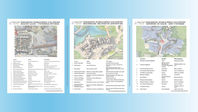Traveling on the Spectrum: Autism-Friendly Travel Tips for Neurodiverse Families
- Practically Perfect Pixie Dust

- Jan 1
- 4 min read
Updated: Jun 30
We love to travel—but traveling with someone who is not neurotypical can feel overwhelming. Whether you’re navigating autism, ADHD, anxiety, or another neurodivergence, it’s easy to feel like managing the unexpected is just too much.

As a family with many “neuro-spicy” members, we’ve found ways to make travel work—not just tolerably, but joyfully. Here’s how we approach neurodivergent travel planning, no matter the destination.


Plan Plan Plan Plan
🧚 Pixie Dust Pro Tip: For neurodivergent travelers, over-prepping isn’t overkill—it’s a lifeline.
We’ve learned that spontaneous trips are not our friend. Whether we’re road-tripping to a National Park or flying to Disney, success starts with research and realistic expectations.
Vacations are pricey—and it’s tempting to squeeze in everything. But for neurodiverse travelers, too many new experiences can be mentally and physically draining. We prioritize slow magic: fewer must-dos, more buffer time.
We also research autism-friendly accommodations ahead of time. Some destinations (like Walt Disney World) offer tools like the Disability Access Service (DAS), while others may require more DIY strategies. Either way, planning ahead gives us a chance to prepare everyone for what’s coming.

Know your family member's needs
Every neurodivergent traveler is different.
For my son on the autism spectrum, predictability is key. He helps research our destination, watches YouTube videos, and contributes to the plan. That sense of control makes a huge difference in his confidence.
My daughter, who experiences social anxiety, is the opposite. Too much information overwhelms her. What works for one neurodiverse traveler may trigger another. That’s why we talk through travel plans together and adjust to meet individual needs.
🧚 Pixie Dust Pro Tip: Planning WITH your neurodivergent traveler—not just for them—can empower and reassure.

Make detailed structured plans
Clear expectations reduce anxiety.
We try to define daily goals and build in bubble breaks—those intentional recharge moments that help everyone stay grounded. Here’s an example of what that looks like:

Today we’ll rope drop Space Mountain, then ride Buzz Lightyear. We'll grab coffee at Joffrey’s and then chill at Carousel of Progress for a bubble break. After Seven Dwarfs (using DAS), we’ll wait standby for Little Mermaid. Then it’s snack time at Gaston’s for a cinnamon roll and another bubble. We’ll head to Haunted Mansion, walk through Fantasyland (crowds ahead!), use DAS for Thunder Mountain, and break for lunch. Then we’ll go back to the resort to swim and decompress before returning at 5pm.
It may seem excessive to map out so much—but having a structure helps ease uncertainty and gives everyone a sense of control.

Maintain flexibility
Even the best plans get derailed.
Surprise crowds, sensory overload, or just “off” moments happen. Sometimes a quick break is enough. Sometimes you need to head back to the room.
🧚 Pixie Dust Pro Tip: If your traveler says they’re struggling—even if they can’t explain why—believe them and shift the plan.
We’ve learned that forcing someone to push through can backfire. It’s better to lose an hour than lose the whole day (or trip). A reset now means more joy later.
Prevent low blood sugar (Seriously)
Hangry + anxious = meltdown waiting to happen.

We always carry snacks. We plan mealtimes in advance and preview restaurant menus for sensory-safe food options. Unexpected changes to food plans—especially when someone is already hungry—can be a major stressor.
Snacks aren’t just a comfort; they’re a strategy.
Final Thoughts
Yes, it’s a lot. But for us, it’s worth it.
We love to travel, and we love our neurodivergent family members. With the right mindset and tools, it is possible to create memorable, positive experiences for everyone.

Want more specific strategies? Check out how we successfully navigate our
Pixie Dust Hugs,
Bren, Lyn, and Kim
P.S. Planning your own magical getaway?
🧩 More Resources for Neurodiverse & Accessible Travel
Looking for more tools to make your trip smoother, more inclusive, and full of magic? Check out our full set of planning guides:
🧠 Disney Travel with Neurodiversity – Sensory-friendly strategies, prep tips, and calm spaces across Walt Disney World.
♿ Limited Mobility at Disney – Stroller-as-wheelchair policies, ride transfer info, and ECV tips for every park.
🎟️ Disney’s Disability Access Service (DAS) Guide – What it is, who qualifies, and how to use it for a smoother park day.
❌ Managing a Disney Trip Without DAS – Alternative strategies if you don’t qualify under new DAS rules.
🧭 Accessibility at Disney Overview – Your hub for all things inclusive, from visual aids to service animal policies.
🌍 Universal Orlando Accessibility Guide – Learn about the Attraction Assistance Pass and how Universal supports guests with disabilities.
📌 Want to save these Quick-Tips for later? Pin or screenshot this quick visual guide!






























































































Comments